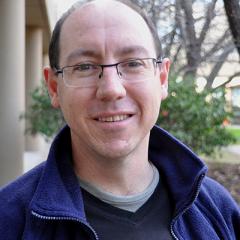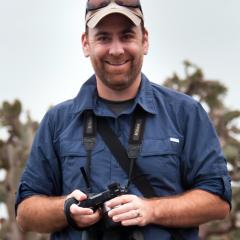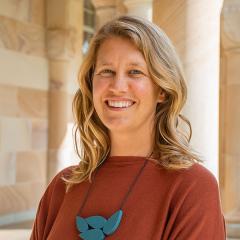I think my background is unusual for an academic at UQ – I grew up in Brisbane. I live in the same suburb – Yeronga – where I went to high school and where my kids go. I also did my undergraduate degree in Maths and Ecology at UQ – and this started my interest in combining these disciplines in my research. And it is in south-east Queensland – specifically in the subtropical rainforests of Lamington National Park – where I developed my love for the environment.
Cape Town in the 1990s
My interest in marine systems, particularly plankton, biological oceanography and fisheries, started during my PhD at the University of Cape Town in South Africa. My research investigated how plankton and the environment regulated the large fluctuations of anchovy and sardine stocks in this rich upwelling system. Living in South Africa was an eye-opening experience. I arrived in the country in 1993 as apartheid was being dismantled. I have vivid memories of that time: of the violence in the country before the election in 1994, such as the armed attack on a church that killed 11 people (I was nearby but luckily a winery was not targeted); of the excitement when Nelson Mandela was elected president; of being held at knife point coming home late after working on my thesis; of being an Australian in South Africa when the Wallabies beat the Springboks, which was unfortunately rare; and of travelling around the great game parks of southern Africa such as Kruger, Etosha, Hwange and Chobe, which kindled my interest in conservation.
The high seas
I returned to a job at The University of Queensland in 2005, where most of my work has focused on large-scale research on the impact of climate change on marine systems, running a national plankton observing system, and global ecosystem modelling to investigate the role of plankton and climate change in fisheries and carbon sequestration. Although I have been involved in marine science for a long time, I am now engaging more with CBCS. I think this is because my interests and expertise in the open ocean are probably more relevant now, especially in marine conservation planning. Protecting the high seas is a growing conservation issue, with the 30x30 initiative, as only 1% of the high seas is currently protected despite representing 45% of the Earth’s surface. Most new protected areas will have to be in the high seas.
My conservation planning work has benefited from strong collaborations with CBCS members Daniel Dunn, Jason Everett, Carissa Klein and Jeff Hanson. Recent CBCS PhD student Isaac Brito Morales developed the first 3-D, climate-smart, spatial plan for the high seas. This has helped springboard our work in large-scale conservation planning. MSc student Lea Fourchault is designing a multi-sectoral spatial plan considering fishing, shipping and deep-sea mining in the Indian Ocean. A recently finished MSc student, Tin Buenafe, has developed climate-smart conservation planning methods that can be easily applied. She is also designing Other Effective Area-based Conservation Measures (OECMs) for Pacific Tuna species. Yet another MSc student, Alvise Dabalà, has developed a global mangrove prioritisation, which maximises ecosystem benefits such as coastal protection, carbon sequestration and fisheries, rather than the typical approach of minimising conflict with the fishing industry. Finally, two other students are expanding a global fisheries-focused ecosystem model to include the export of adult fish and eggs and larvae out of marine protected areas, which should improve estimates of the benefits of MPAs to fisheries, particularly in the high seas.
The coolest (literally!) conservation plan I am working on is in the Southern Ocean. Together with Daniel Dunn, postdoc Jason Everett, and researchers Tin Buenafe and Sandra Neubert, we are designing a network of protected areas in the eastern Weddell Sea, an area the size of France, Germany and Spain. This work funded by the Norwegian Government requires agreement of all 26 members of the Commission for the Conservation of Antarctic Marine Living Resources (CCAMLR) for the implementation of the protected areas. The science is the easy part!
Collaborations and applied research
Through these conservation planning projects we have been able to develop a transferable conservation planning workflow from data processing through prioritisation to visualisation. We have also created innovative climate-smart methods that can be readily deployed and an R Shiny App that runs customised spatial prioritisations in real time, which will be valuable for stakeholder engagement.
I have enjoyed my increased research focus in marine spatial planning. It has been especially rewarding seeing students gain expertise to become skilled R programmers, and I have enjoyed the more applied research. I would like to thank CBCS for fostering collaborations with Daniel Dunn, Carissa Klein and Jeff Hanson. And a big shout out to Jeff Hanson, as I think his R prioritizr software is a game-changer and I encourage anyone doing spatial planning to try it. Finally, anyone interested in marine conservation planning in R and learning quantitative skill please reach out.
Teaser image: CSIRO
Image above: Julian Uribe, CSIRO and IMOS



